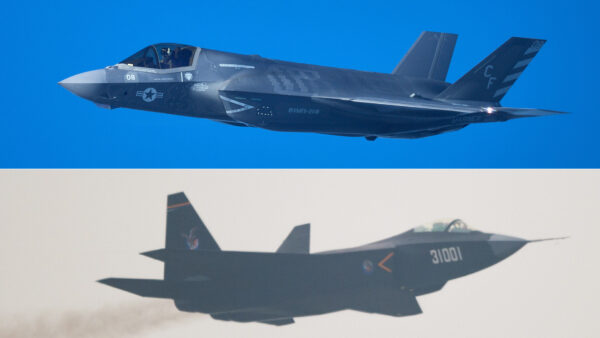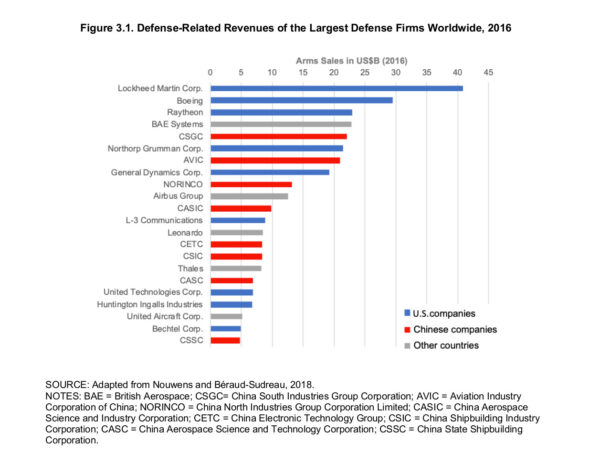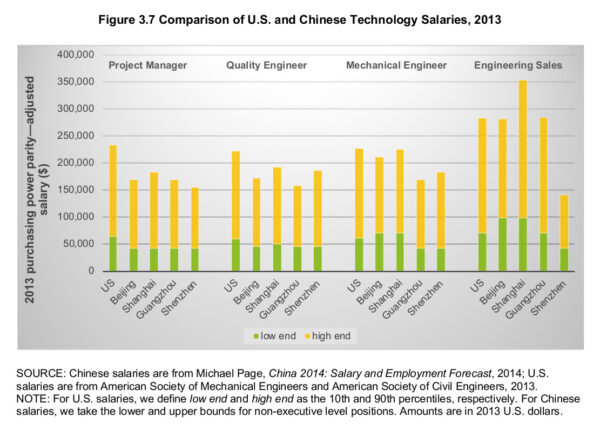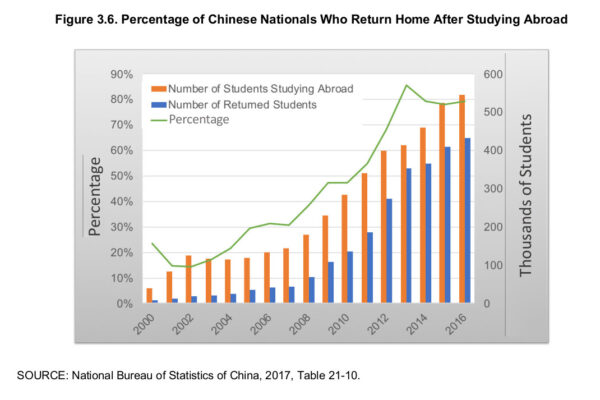China Spurs Domestic Military Sector With Stolen Tech, R&D Investment: Report
China is racing to catch up to the military superiority of the United States, and it’s doing so by beefing up domestic innovation efforts in tandem with ongoing intellectual property theft efforts, according to a recent think tank report.
At the same time, the military arm of the Chinese Communist Party (CCP) is hindered by both the trappings of a socialist command economy and an inability to develop cutting-edge technology on its own, according to the RAND Corporation report (pdf) “Defense Acquisition in Russia and China.”
“China’s reliance on intellectual property theft means its weapons are years behind, but the Chinese recognize that shortcoming and are investing in and growing organic capabilities through joint ventures and acquisition of foreign technology,” the report reads.
The report, drafted for the U.S. Army, outlines how China is moving away from its standard model of copying other countries.
“Overall, the PLA [People’s Liberation Army] has overcome many technological barriers and is the clear pacing threat to the United States in defense acquisitions,” it reads.
Theft and Acquisition
The Chinese innovation model for years has been to steal and replicate, which the RAND authors refer to as the “copy-replace model.” Many divisions of the People’s Liberation Army (PLA) are armed with replicates of other nations’ weaponry.
The report notes that Chinese aircraft bear striking similarities to their U.S. and Russian counterparts. Among the list of potential replicates is the Chinese J-31 Gyrfalcon, which resembles the American F-35 Lightning II.

Another jet, known as the J-20 Mighty Dragon, is similar to the American F-22 Raptor. But according to the report, despite the J-20 going through relatively quick development, the report estimates that China is as far as 20 years behind the United States in military aviation.
On the ground, the PLA’s domestically produced standard service rifle of roughly the last 25 years, the QBZ-95, may soon be replaced by a copied model. The replacement, which is unofficially known as the QBZ-191, is a near copy of the Heckler and Koch 416, according to analysis from The Firearm Blog. This rifle is also strikingly similar to an AR-15.

The CCP’s “reliance on theft of intellectual property for its weapon development has helped keep it competitive but has pegged it several years behind the cutting edge,” according to the report. This has led China to increase efforts in its own research and development.
Innovation
China’s domestic military spending has been on the rise in recent decades, and its approach to innovation has been met with a paradigm shift in recent years.
“Chinese military expenditures grew tenfold in constant dollars over the past 25 years, with spending reaching an all-time high of $250 billion in 2018,” the report reads.
By comparison, the United States had a defense budget of $700 billion that same year.

Chinese leader Xi Jinping’s takeover of the CCP in 2012 led to several systemic changes in the PLA’s weapon development strategy. Since 2016, the military and commercial sectors have become more closely integrated. Military designs are often contracted out to civilian, albeit state-owned, companies.
“For a sense of scale, of the top 22 highest-grossing defense firms worldwide, nine are from the United States and eight are from China,” the report reads.
Chinese salaries for project managers and engineers are also becoming competitive with the United States. This further serves to lure Chinese nationals attending universities abroad back home.

Almost all Chinese students began living abroad after graduating in 2000. By 2016, nearly 65 percent of Chinese students had returned to China.
Barriers to Battle
Money and theft aren’t able to solve all of China’s development problems.
“The PLA is still struggling to spur domestic innovation and close the gap on a few glaring technical deficiencies, such as high-end chips, silent submarines, and aircraft engines,” the report reads.
The RAND authors highlight internal impediments stemming from the political structure of communism.
“Even as it strives to clear these technical hurdles, the PLA must address the institutional inefficiencies and barriers related to management and quality assurance that continue to frustrate its efforts at reform,” the report reads.
Many Chinese businesses’ internal hierarchies are based on the duration of employment and personal relationships, rather than meritocracy. Despite large numbers of students returning to the country, many existing Chinese companies fail to effectively integrate returning talent, the report states, citing ineffective management practices.

“The design of Chinese defense contracts also does little to encourage transparency and accountability,” the report reads.
The language in contracts is vague, contract winners are guaranteed a share of profits on top of costs, and low bidders for contracts are given consolation projects. These vestiges of the command economy result in little to no incentive to innovate, according to the report.
https://besacenter.org/the-american-colossus-may-crumble/
The American Colossus May Crumble
BESA Center Perspectives Paper No. 2013
EXECUTIVE SUMMARY: The US is no longer the country that recovered from the Pearl Harbor disaster and won WWII, or that both morally and economically sustained itself throughout its prolonged ideological conflict with the Soviet Union. The people of the once great country are confused and disoriented. Once America’s feet of clay crumble, the colossus will never rise again.
“A colossus with feet of clay” is how many, allegedly including Winston Churchill, used to describe the Soviet Union, one of the superpowers of the last century. That description attested to the country’s bombastic rhetoric coupled with its perceived military might juxtaposed against the inherent lethal flaws of the Soviet political and economic system.
A country’s ability to survive a serious crisis depends not only on the creation and implementation of effective strategies by the elite, but more importantly on the willingness of its citizenry to sacrifice and stand together. The people must identify with the state—to believe the country’s future is their future—to the point that they are willing to die for it. A country whose population lacks this sense of common purpose and identification is a country in jeopardy, no matter how large or powerful it is.
As the New Cold War between the US and China heats up, most articles and papers analyzing the situation are concerned with the relative military might of the two sides. Every destroyer, every drone is counted to determine if China has the ability to defeat the US in a hypothetical military engagement. This is an important question, but there are two other questions of much greater significance considering the current balance of power: 1) Can China deliver a devastating yet non-debilitating strike; and 2) How will the people of the great democracy react?
Now that it has eliminated Hong Kong’s tenuous independence, Beijing has set its sights on Taiwan, as President Xi Jinping has made clear on more than one occasion. While China does not possess the capability to defeat the US in a full-blown conventional conflict, it does have enough firepower to temporarily neutralize the regular American presence in the region and conquer Taiwan. Strategically, this is exactly what China needs to do to achieve multiple short- and long-term objectives.
Let’s look at a hypothetical scenario. China surprises the US with a preemptive strike and manages to sink or disable most of the battleship groups located in the South Pacific. It wreaks havoc on the area’s communication networks. It then lands forces on Taiwan, overwhelms its defenses, and declares the island part of Greater China.
At that point, Beijing unilaterally declares the conflict over, offers unconditional peace negotiations, and even offers the US financial compensation for the human or material losses incurred. And in the process, it declares that any attempt to retake Taiwan will be considered an attack on sovereign Chinese territory, and it reserves the right to a nuclear response.
This scenario reads like a repeat of Pearl Harbor, but there is a critical difference: the degree of American resolve. The events described above would generate massive anti-war demonstrations in cities across the US. They would bring the economies of those cities to a virtual standstill and lead to violence reminiscent of the BLM demonstrations of the summer of 2020. The war effort would be declared another attempt by the white supremacy to impose its racist will on a rising developing nation. The unions would join the call and refuse to unload any military-related cargo at Pacific ports. The US would be engulfed in chaos. The president would ask for war powers and either be denied them or receive them with a razor-thin majority. Lacking the legitimacy to involve the country in an all-out war, he or she would be forced by “public opinion,” the entire mainstream press, and Wall Street to accept the terms offered by China.
That may read as a grotesque fantasy. Sadly it is not, when one looks at data collected over the past few years regarding the attitudes of Americans, and specifically young Americans, toward their own country. We see a large proportion of citizens aggressively hostile to the existence of their country in its current form and another large group ambivalent on the subject. The former is bent on destroying the US by any means necessary, as it considers the country an evil enterprise whose demise is long overdue. The latter will stand by in silence.
Taiwan is more than just a democratic island. Its loss in such a hapless way would bring an end to Pax Americana, the American order in the South Pacific, Asia, and likely in the rest of the world. A superpower unable to defend its allies or itself loses all credibility. A dramatic economic crisis would likely occur, with the yuan replacing the dollar as the currency of international trade.
Comparing the current confrontation between the US and China to the Cold War is only partially correct. China does have many political similarities to the Soviet Union, but while the Soviet Union was a socialist experiment in a perpetual economic coma, China’s economy is the second-strongest in the world.
Yet the main difference between now and then is the US itself. It is no longer the country that responded to the Pearl Harbor disaster with sufficient resolve and national unity to win the war, or that was able to sustain itself both morally and economically throughout the prolonged ideological conflict with the Soviet Union. Americans of today are confused and disoriented. Once their country’s feet of clay begin to crumble, the colossus will never rise again.
Lev Stesin is a computer scientist.
And:
Brilliance in 3 Parts
A Back off and let those men who want to marry men, marry men.
B. Allow those women who want to marry women, marry women.
C. Allow those folks who want to abort their babies, abort their babiesIn three generations, there will be no more Democrats.part II:10 Poorest Cities in America (How did it happen?)City, State, % of People Below the Poverty Level1. Detroit , MI 32.5%
2. Buffalo , NY 29.9%
3 Cincinnati , OH 27.8%
4. Cleveland , OH 27.0%
5. Miami , FL 26.9%
5 St. Louis , MO 26.8%
7. El Paso , TX 26.4%
8. Milwaukee , WI 26.2%
9. Philadelphia , PA 25.1%
10. Newark , NJ 24.2%(Now, watch closely... at no time will the fingers leave the hands...) What do these top ten cities (over 250,000 pop.) with the highest poverty rate all have in common?
Detroit, MI - (1st on poverty rate list) hasn't elected a Republican mayor since 1961
Buffalo, NY - (2nd) hasn't elected one since 1954
Cincinnati, OH - (3rd) not since 1984
Cleveland, OH - (4th) not since 1989
Miami, FL - (5th) has never had a Republican mayor
St. Louis, MO - (6th) not since 1949
El Paso, TX - (7th) has never had a Republican mayor
Milwaukee, WI - (8th) not since 1908
Philadelphia, PA - (9th) not since 1952
Newark, NJ - (10th) not since 1907
Einstein once said, 'The definition of insanity is doing the same thing over and over again and expecting different results.'It is the poor who habitually elect Democrats ... yet they are still POOR.
Part III:
"You cannot help the poor by destroying the rich.
You cannot strengthen the weak by weakening the strong.
You cannot bring about prosperity by discouraging thrift.
You cannot lift the wage earner up by pulling the wage payer down.
You cannot further the brotherhood of man by inciting class hatred.
You cannot build character and courage by taking away people's initiative and independence.You cannot help people permanently by doing for them, what they could and should do for themselves."
~ Abraham Lincoln
"Any man who thinks he can be happy and prosperous by letting the government take care of him had better take a much closer look at the American Indian." ~ Henry Ford
+++++++++++++++++++++++++++++++++++++++++++++++++++++++++++++++++++

No comments:
Post a Comment